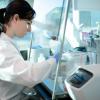Can environment and architecture improve the way that we work together? We take a tour of the UK’s new landmark biomedical research centre to find out.

The Francis Crick Institute is the new £700m biomedical science research centre that towers over London St Pancras. The building, which is 170 metres long and just under 50 metres high, has a fl oorspace of nearly a million square feet – that’s the size of 17.5 football fi elds. There is a whole dossier of amazing facts and fi gures about the building: it has 1553 rooms (twice as many as Buckingham Palace); 25,000 sensors constantly monitor the environment; and air actually leaves the building cleaner than it entered (see fact file for more). However, as impressive as the construction and design details are, it is the manner in which the built environment is hoped to infl uence the research within that is vital to the institute.
A collaborative approach
A spokesperson says that the design “deliberately nudges” inhabitants towards collaboration. He continues: “The atrias cross at the centre of the building to create a hub with break areas, informal collaboration space, and a large central stair. Walkways and informal meeting areas crisscross the main atrium and connect neighbourhoods.” It is something that is immediately obvious as you walk around the vast building. “There are lots of cohabited open spaces and conversation happens everywhere, you always bump into people,” says Dr Lucy Collinson. “You have to add 10 minutes to your journey time when you go anywhere in the building. You bump into people and start to discuss things that may or may not build up into projects.” Dr Collinson is the Head of Electron Microscopy at the institute. Along with her colleague Dr Luiz Pedro Carvalho, who runs the Mycobacterial Metabolism and Antibiotic Research Group, she is showing The Biomedical Scientist around the new institute, which was founded by six leading scientific and academic organisations and was officially opened by the Queen at the end of last year.
Walking past groups of soft sofas where scientists are having heated debates, Dr Carvalho says: “It is a whole campus housed inside one building. It’s the largest in Europe under one roof and just by geography and environment we are forced into circumstances that change the way we work. “For example, I don’t really know what electron microscopy is, but I’m working with people who are experts in it, so it’s pretty likely that my work will involve electron microscopy. “Diff erent advances will come from diff erent approaches,” he continues. “If you only do things that you are comfortable with, that will stop you having breakthroughs. In my lab we have 10 people and none of them can do the same thing, there’s no overlap at all.”
A unique breakthrough The diverse multidisciplinary approach is already paying dividends, with Dr Carvalho’s team fi nding a promising target in the search for new tuberculosis drugs and, in the process, uncovering the potential strengths of a new research technique called “metabolomics”. The team has demonstrated that mycobacterium tuberculosis is destroyed by blocking a specific protein called glutamate racemase, which is targeted by an antibiotic compound known as BCDA.
But potentially as important as this discovery is the manner in which it was made, with the team drawing on the emerging fi eld of metabolomics (the large-scale study of small molecules within cells, biofl uids, tissues or organisms) to learn how the bacteria that cause tuberculosis are destroyed. Dr Carvalho says: “We know that bacteria vary in their response to antibiotics but often not how or why. This limits our ability to fi nd new antibiotics. “Metabolomics has huge potential to show exactly how diff erent species of bacteria are damaged by antibiotics and so, in turn, could be used to identify new targets for drug discovery. We believe our research is the first successful application of metabolomics to identify the target of an antibacterial compound.” He adds: “We would never have discovered that glutamate racemase was the target of BCDA without the use of metabolomics techniques. The use of metabolomics in combination with enzymology and tuberculosis biology is almost unique to our lab.”
Gentle anarchy
The discovery demonstrates the potential of the “gentle anarchy” approach employed by the director of the institute, Sir Paul Nurse, who says “the building is designed to break down barriers – having a bit of gentle anarchy is good”. This is apparent throughout, with barriers literal and imagined removed and challenged. From the open-plan labs and the glass walls, to the open atrium that links the fl oors above ground level – every eff ort has been made to connect people from diff erent disciplines. “We have people from chemistry, maths, biology and physics and if we need equipment that doesn’t exist, then we have the ability to build it,” says Dr Collinson. “When you have different people from different backgrounds looking at something together, they start to see it in different ways. “Part of the appeal of working here is that I get to sit down with the best scientists in their specialist areas and have personal one-to-one discussions, which wouldn’t be possible elsewhere.”
Silicon valley
The idea of putting all the brightest minds in one place to interact is not new. It has been happening in Silicon Valley since the 1970s when Hewlett-Packard adopted an open work environment to encourage interaction between engineers. Fast-forward to 2004, and Facebook’s original headquarters utilised a neighbourhood design concept, organised into streets, town centres, and food districts. This was done in a bid to defi ne the workplace, encourage collaboration and refl ect its informal culture. Win Roney, Vice President of HGA Architects and Engineers in San Francisco, has worked extensively on projects for tech companies.
He says: “As innovators, Silicon Valley tech companies were the fi rst to adopt new, casual attitudes about the workplace – they re-imagined how it could function. “For example, instead of being separated by specialisation, workers were teamed together. Flexible work schedules and casual dress were embraced. And with the advent of mobile technology and the subsequent rise of the 24/7 workplace, the function of the office was no longer to provide a space for employees just to work – it also was a place for workers to engage and collaborate with other employees.”
24-hour workplace
Discussing daily routines, as the lift takes us towards the top of the Crick, it seems the 24/7 workplace is a concept that has also made its way over from Silicon Valley. “My day starts the minute that I get out of bed and check my emails,” says Dr Collinson. “Then I’ll be working on the bus on my way into work, and then after I fi nish here, I’ll continue into the evening – science is a 24-hour endeavour.” Dr Carvalho adds: “Yes, it is a 24-hour thing and my routine is the same, but when I check my emails fi rst thing, I do it in bed, because I am lazier than Lucy.”
Looking down over the visible floors of the Crick, scientists can be seen gathered in groups and walking together down the spacious corridors, deep in discussion. The idea that environment can encourage multidisciplinary working seems to be one that rings true, while early research results, such as Dr Carvalho’s metabolomics work, show that there is the potential for findings which may not have been possible in a more traditional environment.
The ideas may be imported from Silicon Valley, but translating them into biomedical research on this scale is something new. If the Crick can mirror the progress and innovation that has been possible for cutting-edge tech companies thanks to environment and building design, then the institute will be recognised even more for its pioneering biomedical work than its incredible building and slick glass façade.




